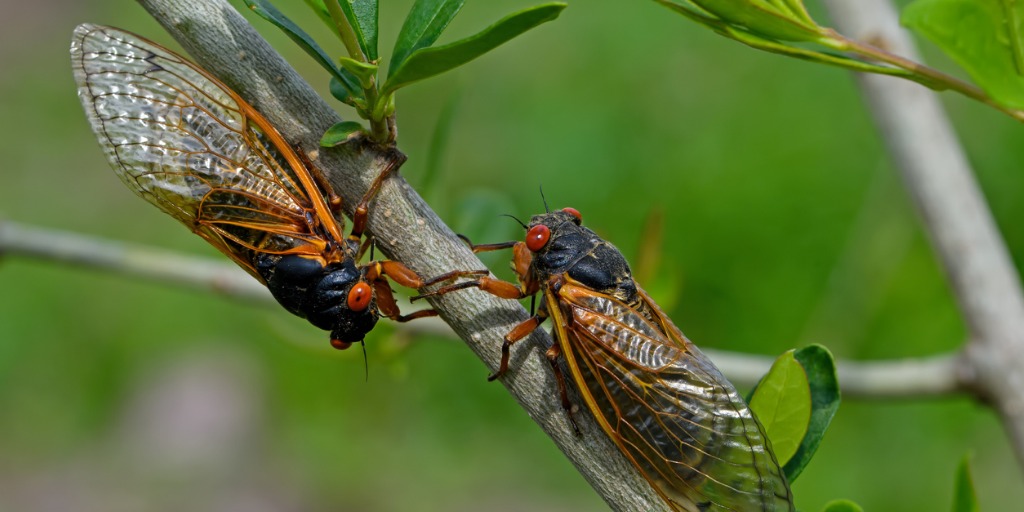| By K. Lee Lerner |
With the 2024 solar eclipse excitement behind us, people living in the Southeast and Midwest are now anticipating a rare double emergence of major periodical cicada broods.
A brood is a group of cicadas synchronized to emerge from the ground to complete their life cycle by molting, mating, laying eggs, and dying. There are currently 12 known broods of cicadas with 17-year life cycles and three known broods with 13-year life cycles. Broods also have defined geographic locations and ranges, but all 15 known periodical cicada broods exist only in the eastern half of the United States.
In 2024, cicadas from Brood XIX and Brood XIII are expected to emerge in the United States. This overlap is so rare that the last time these broods emerged at the same time, in 1803, Thomas Jefferson was the U.S. president.
The Roman numerals (I to XXX) currently designating periodical broods include broods that are extinct, or that were minor emergencies in years not expected.
The two primary species of periodical cicadas in North America are Magicicada septendecim, which has a 17-year cycle, and Magicicada tredecim, which has a 13-year cycle. These periodical cicada species, along with others in the Magicicada genus, exhibit synchronized emergences in various broods across different regions. Some Magicicada exhibit 22-year cycles.
While any of the 13-year broods and 17-year broods may occasionally emerge at the same time, extreme climatic conditions might throw off a brood’s cycle. Although the broods expected to emerge have different locations and ranges, they may overlap in certain areas of Illinois.
After 2024, Brood XIII and Brood XIX won’t be expected to emerge at the same time again for another 221 years.
The density of cicadas will vary. It’s likely to find higher-density pockets in more forested areas or areas with a rich tree canopy. Entomologists have estimated that ideal habitats can support up to 1.5 million cicadas per acre.
Later in the summer, annual cicadas will sing their song into the sultry summer night, but periodical cicada broods hatch earlier. Starting in April 2024 and extending to about the first week in July, billions of cicadas will emerge. Multiple online sites sponsored by universities and interested groups host reports of outbreaks, maps, predictions, photos, and even cicada recipes.
When growing underground, cicadas attach themselves to tree roots and feed via a rostrum used to suck fluids from a tree’s xylem tissue. While precise mechanisms are not yet known, scientists do know the cicada can discern the passage of a year by changes within the fluid passing through the xylem. How they “remember” the count of years that have passed or what signal tells a brood it’s time to emerge awaits further scientific investigation.
Cicadas normally begin to emerge when the soil warms to 64°F at a depth of about 8 inches below the surface. After they emerge, they climb vertically and attach themselves to trees and other objects in order to molt (shed their exoskeleton) and then unroll and dry (inflate) their wings. A mass of males typically emerges first, and predators feast on them until satiated. More males and most females emerge next. Within a few days, they also molt, inflate their wings, and enter the mating ritual.
Each cicada species has a distinctive song. It’s the males who sing. Their largely hollow bodies and specialized tymbals can create a call that joins in a loud chorus to reach more than 90 decibels—about the loudness of a lawn mower—while females snap and click to denote their readiness to mate.
After mating, the female cicada uses a saw-like ovipositor to cut slits into small tree and woody plant branches, into which she lays about 10 to 20 eggs at a time, until there’s a total of about 500 to 600 eggs. The small cuts generally don’t harm larger trees, but young, small trees growing in areas where cicadas emerge benefit from being wrapped with small mesh protective nets, recommended by the local agricultural service.
Cicadas are bioaccumulators, so the use of insecticides is highly discouraged. Native Americans have historically used cicadas in their diets (usually eaten after they molt) in both feast rituals and to stave off famine.
When the eggs hatch about six to 10 weeks later, depending on the species and weather conditions, the cicada nymphs drop to the ground, feed on grassy roots, and start to dig down into the soil to find suitable tree roots off of which to feed during their long maturation underground.
The annual cicadas that will appear later this summer in many areas of the United States are larger, darker, and generally have white undersides. They also lack the distinctive orange wing veins and red eyes of periodical cicadas. While they have two- to five-year life cycles, some cicadas appear every year because their life cycles aren’t synchronized.
Anyone interested in participating in the scientific reporting of cicada emergences can do so via the Cicada Safari app.
 About the Author
About the Author
Recognized for his use of language, accuracy, and balanced presentation, K. Lee Lerner’s portfolio covering science and global issues for Cengage includes two ALA RUSA Book and Media Awards and two works named Outstanding Academic Titles. Holding degrees in science, education, and journalism, including a master’s degree with academic honors from Harvard, Lerner has served on the board of advisors for the venerable American Men and Women of Science since 2003 and, along with Brenda Wilmoth Lerner, as coeditor for three editions of the Gale Encyclopedia of Science. He was the contributing editor-in-chief for Gale’s Encyclopedia of Espionage, Intelligence, and Security. A member of the National Press Club in Washington, DC, Lerner is an experienced aviator and sailor who has completed two global circumnavigations. His Academia site consistently ranks among those most frequently accessed by students, scholars, and decision-makers from around the world. Additional information may be found at https://scholar.harvard.edu/kleelerner and https://harvard.academia.edu/KLeeLerner/




